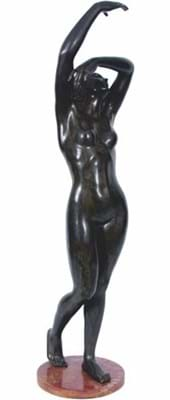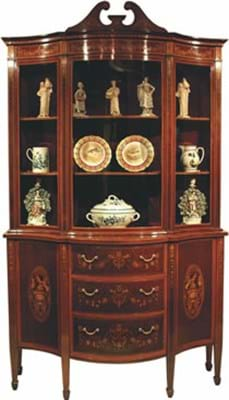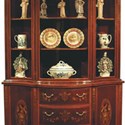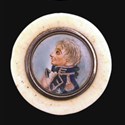"One of our best quarterly sales in a while," said auctioneer Mark Gilding before warming to his theme and adding: "It was fantastic."
It came on top of a series of monthly sales which are becoming higher profile events for which Mr Gilding credits the internet. On one level are the buyers in the room sweeping up the box lots to sell their contents individually on eBay. On another, bidders that come to the sale via the internet are also scooping up those currently difficult pieces which sell in the low two-figure range.
As to the quarterly event, he admits: "Getting the right material in is getting more difficult but when we offer it, it does sell."
The right stuff, of course, does tend to mean the right names, and the later the date of an object, the more true this becomes.
The day's best seller was a piece of Edwardian furniture - the 4ft 4in wide (1.32m) display cabinet illustrated on this page had two-fold appeal. It was profusely inlaid and decorated with lyres, floral swags, sunbursts, ovals of vases and acanthus scrolls and, crucially, was an Edwards & Roberts piece.
Mr Gilding was a little nervous about the £6000-8000 estimate, but the cabinet, with original penwork and in fine condition, went to the trade at £9000.
His £500-800 estimate on a good, but straightforward 6ft (1.83m) wide bowfront mahogany sideboard with walnut crossbanding seemed geared to the depressed market - particularly as bidders were told it was probably early Victorian rather than Regency as catalogued. Such a classic piece - central long drawer flanked by cupboard and cellaret with inlaid spandrels - might have made four times that top estimate a couple of years ago and when this example went to the trade at £2900 there was a mood (naturally well disguised) of spirits being lifted.
On the other hand, good, but anonymous, Arts & Crafts material still seems cheap. Here a set of six distinctive oak elbow chairs with panelled tapered backs, shaped arms and drop-in sets on square legs, catalogued as possibly Glasgow School, seemed very good value at £1050 the lot. That was comfortably over the £800 top estimate but should allow the trade buyer some room for a profit.
A major name was the highlight among the 60-lot objets d'art section - a nude female bronze stamped H. Chiparus and numbered 1920 on the circular marble base. The vendor's reserve was a shade high on the 4ft 4in (1.l30m) nude but it found a local trade buyer a little under estimate at £4600.
Sadly, in these anti-smoking days the stamp of Cartier, Paris wasn't enough to persuade bidders to get near enough to the £2000 lower estimate on an elegant white 3in (6.5cm) tall slimline gold cigarette lighter mounted with 35 small diamonds.
However, in this bicentenary year of Trafalgar, Nelson's name boosted the bidding on three 19th century 1in (2.5cm) diameter bone patch boxes, with lids inset with paintings of the admiral, his lady love Emma Hamilton and his ship HMS Victory.
The Victory box had a noticeable crack through it, but the trio took £950 from a local dealer against top hopes of £700.
The Nelson touch was also evident among the opening ceramics. Here a late 18th century pearlware jug with moulded portraits of Nelson and his gallant, if now rather forgotten, friend Captain Edward Berry, carrying top hopes of £150, the 6in (15cm) jug was a trade buy at £520.
Always an attractive name among the toby jug fraternity is that of Ralph Wood.
A late entry to Gilding's sale was a 9 1/2in (24cm) Staffordshire toby of a gentleman with flagon and foaming glass "in the manner of Wood' and estimated at £60-100.
The London/local trade battle which ended in a £1350 victory for the latter suggested this was the real thing.
More expected was the top bid among the ceramics - a mid-estimate £2300 from the trade on a 16in (41cm) pair of Royal Worcester figures of a Japanese gentleman and a lady date-stamped for 1922.
The major surprises were two early 18th century drinking vessels in the glass section. An 8in (20cm) baluster glass with tapering bowl engraved with a fox and the words Vivat Herman vos anno 1709, and a 10in (25cm) ale glass with a funnel bowl on knopped tear-drop stem. Each estimated at £100-150, but both well enough illustrated to catch the specialist eye, they sold at £1310 and £1550 respectively.
Top names and the Nelson touch raise the standard of quarterly sale
Gilding’s, Market Harborough, March 8, Buyer’s premium: 12.5 per centTHE decision by Leicestershire auctioneers Gilding’s to cut back their fine sales from six a year to quarterly events is perhaps a sign of the times, but the 510 lots offered in March appeared to signal that the shires are weathering the depression.










